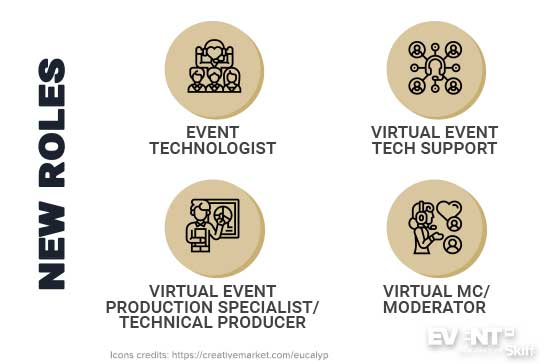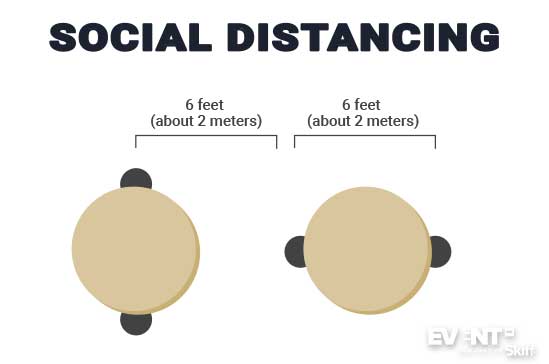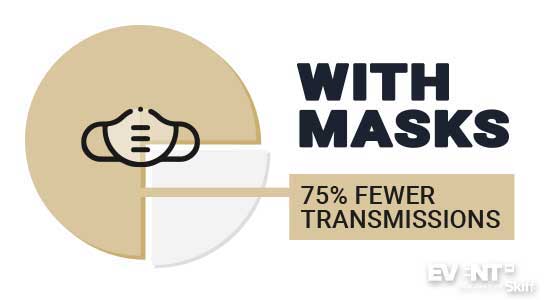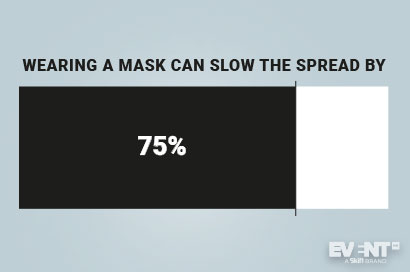Skift Take
With states and countries starting to open back up, it's time to start thinking about the future of in-person events and what those will look like. This guide will help you begin that process and start organizing physical events post-lockdown.
The pandemic has brought with it unprecedented losses and challenges for the events industry, but also the rise and popularity of virtual alternatives. As in-person events start to take place again, event planners will have to acknowledge the role of virtual as they face the task of organizing these mass gatherings with the still very real threat of Covid-19.
The reality is that, as long as the virus continues to spread, it is especially risky to congregate indoors — a recent study from Japan found that the virus is almost 19 times more likely to spread from person to person in a closed environment.
The new normal for physical events will entail thorough safety measures and will rely heavily on virtual tools, so it’s important to prepare accordingly. We’ve compiled this comprehensive guide to planning and executing post-lockdown events to help you navigate the immediate future of events.
Pre-Event Considerations
Tailor Your Marketing Strategy
When it comes to marketing your event, not everything has to be a departure from pre-Covid times, but there are certain things to keep in mind given the current environment.
MESSAGING
Justifying hosting an in-person event and convincing attendees that it’s worth traveling to is more challenging than ever, so you need to be that much more clear and focused as you communicate your value proposition in your marketing materials.
Remember to be sensitive to the current global situation and acknowledge the challenges that many are facing — especially regarding the ability to attend an event and economic hardship more broadly. Be sure to make it clear that there will be an online component, and to address and emphasize the safety measures that you’ll be implementing onsite.
Why should your attendees attend?
Why should they attend live when a virtual option may be available (or several, depending on the nature of your content and the competitive landscape)?
As you will likely have to include a virtual component, make sure you answer these questions tactfully and with positive reinforcement to avoid undermining the perception of its value. That is, speak to what else you get from attending live in addition to the value of the virtual content and engagement.
IFA Berlin, which will take place in September, is a great example of how to convey value proposition:
#IFA20 will focus ⁰on its four core functions:⁰
1. An innovation showcase for brands
2. A platform for cutting-edge technology
3. A global sourcing event for OEMs and ODMs
4. As a marketplace where retailers and brands can come together. pic.twitter.com/BK1qndj6Vd— IFA Berlin (@IFA_Berlin) May 19, 2020
TIMELINE
Finally, keep in mind that virtual participants won’t necessarily follow the same registration timeline as in-person attendees, since they don’t need to make travel arrangements. They have the luxury of making more last-minute decisions and will likely register later. Adjust your marketing timeline accordingly to account for the fact that you’ll need to attract both in-person and online attendees.
Plan for Virtual Attendance
In the immediate post-lockdown environment, it will be nearly impossible to host a live event without any virtual component. Providing online channels for people to join the event will allow you to reach — and monetize — a much larger audience. Keep this in mind when designing your event to ensure your format makes sense for both types of attendees.
ENGAGEMENT
Make sure you plan for ways to include your virtual audience in the event and allow them to network instead of solely focusing on the in-person experience. According to Bob Vaez, CEO and Co-Founder of Eventmobi, the three most important aspects of virtual engagement are quality presentations, attendee participation, and virtual networking.

He recommends crafting presentations around the hero’s journey to make your audience feel invested in what you have to say, as well as using tools such as live Q&A and polls to allow them to interact with speakers. Networking options are equally important, which can be in the form of video breakout sessions or workshops.
Consider making a recording of the event sessions available online (for free or for a fraction of the ticket cost) to provide even more flexibility for people who aren’t able to join.
TICKETS
Again, it’s important to keep in mind that virtual attendees will also differ from in-person attendees in terms of their willingness to pay for access to the event. However, if you can effectively convey and prove the value of your event, you’ll more easily be able to justify the price tag.
Keep in mind that you can keep ticket prices low for online attendees and still potentially generate a higher ROI given the scale of the event. It’s important to set a fair price to be able to strike a balance between what people are willing and able to pay, and the financial viability of the event from a business perspective. A tiered pricing structure and/or flexible cancellation policies are some options to consider.
TECHNOLOGY
In order to effectively set up virtual engagement opportunities for your event, you’ll need the right hardware and software. Almost 70% of eventprofs are searching for tools that support both in-person and virtual events — and the market is quickly adapting to meet this demand.
Don’t hesitate to look for a partner to help with the tech side of things, whether it’s a newly-created virtual venue or another virtual event specialist.

Some key things to consider when selecting a tech partner include:
- What types of events they’re used to working on or what their tool is best suited for
- Any technical restrictions that may apply, including attendee or bandwidth limits
- Integration capabilities
- Sponsorship opportunities
- Engagement and networking features
- Data collection policies
LANGUAGE BARRIERS
Given that international travel is unlikely in the short-term, there shouldn’t be many language barriers between in-person attendees. However, you’ll be able to reach people all over the world through virtual. Consider crafting your communications in a way that can be easily understood by non-native speakers, or translate key information into the relevant languages to better engage these audiences.
Prepare the Registration Process
Although it’s still important to collect standard attendee data and ask questions regarding their preferences, think about what information you may need to gather beyond what you normally would when creating your registration pages and forms.
COVID-SPECIFIC QUESTIONS
In the early days of the pandemic, certain public health authorities tried to mitigate risk by requiring events to prove that attendees would not be traveling from high-risk areas and had not had any contact with people from these areas. This can be difficult to accurately prove, but if such restrictions come into play post-lockdown, it’s reasonable that these questions would feature in your registration process.
Consider adding questions about:
- Where they’ll be traveling from
- Whether they’ve recently tested positive for Covid-19 or been around someone who has
- Whether they have previously been tested for antibodies for the virus
- Their perceived risk status, including age group, health condition, etc.
At the moment, there are no set guidelines for information collection, so it will be up to each planner to decide what is appropriate and what works for their event.
TERMS, CONDITIONS AND LIABILITY WAIVERS
It may make sense to have attendees sign a liability waiver if they plan to attend, since most insurance plans are no longer covering pandemic-related claims (if they ever were) and a positive diagnosis coming out of your event can potentially open you up to legal trouble.
You should also include a statement for attendees to review regarding the onsite safety measures and have them agree to abide by the rules you’ll be setting forth (as well as any actions that may be taken against participants who fail to follow them).
In addition, remember to carefully consider cancellation and refund policies — it’s too early to tell with absolute certainty when it will be safe to put on an event or whether future spikes in outbreaks will prompt further postponements and cancellations. Be sure to clearly outline the terms and conditions for all foreseeable situations.
Update Your Attendees
Keeping your attendees informed is always a key part of the planning process, and even more so during a pandemic.
SAFETY INSTRUCTIONS
Send specific onboarding materials to your in-person attendees prior to the event to let them know about important safety measures and make sure they can prepare accordingly.
You should include:
- What they can expect from the event, including any rules on social distancing, mask-wearing, etc.
- Information on whether you will be providing masks and other safety gear (which you absolutely should be), or implementing temperature checks upon arrival
- A review of standard safety guidelines, such as frequent handwashing and using hand sanitizer
- Clear discouragements to anyone who is feeling sick from traveling to the event
- What measures will be taken onsite if anyone falls ill
Select Appropriate Venues
Choosing the right venue will entail evaluating the safety measures for in-person audiences and the tech infrastructure/set-up for virtual audiences.
HYBRID CAPABILITIES
Reliable internet and modern AV technology will be a bare minimum for the sort of high-production-value virtual experiences virtual audiences will be expecting. Look for venues that offer these features and that will be able to accommodate your virtual event needs.
CORONAVIRUS PREPAREDNESS
The sanitation procedures and social distancing measures that will be required represent an additional cost that venues are better positioned to absorb, as being the sites of physical events will allow them to more easily spread the investment over more events/attendees.
Consider these questions when sourcing venues:
- Are there separate entrances to limit the amount of people going in and out the same way?
- Is the space easily set up for one-way foot traffic or spaced-out tables and chairs?
- Is there adequate ventilation inside to help prevent the buildup of the virus in the air?
- Have they invested (or do they plan to invest) in any onsite testing capacity?
Onsite Preparation
The physical aspect of the event will be drastically different from events that you’ve put on in the past and will be challenging to execute. Here’s what to keep in mind when preparing the venue.
Implement Proper Safety Protocols
Safety measures will be paramount at events taking place in the near future. The following are elements to consider when gathering attendees at a physical venue.
SOCIAL DISTANCING
It goes without saying that the number of in-person attendees should be kept to a minimum to allow for better social distancing, which most venues will be enforcing. Stationary chairs and tables should be placed at least 6 feet (about 2 meters) apart to minimize spread.

Think about how the space should be set up and what procedures will need to be enacted to ensure that everyone can remain distanced when moving around.
For example:
- Place markers on the ground and include clear signs to indicate the flow of traffic and limit people having to cross paths. These markers can also be used as an additional opportunity for branding or sponsorships.
- Establish a protocol for entering and exiting sessions and halls.
- Keep the minimum recommended distance in mind when designing attendee-staff interactions, like at check-in, information desks (apps can be an effective way to replace these), and meal times. One option would be to have meals plated and tabled when attendees arrive to minimize staff interaction with guests during table service.
SCREENING INFRASTRUCTURE
As mentioned above, thermal scanning will be a minimum requirement for many events during the pandemic, although it may not be the most reliable way to test people for the virus. Researchers are still hard at work developing alternate testing methods, such as a new laser testing technology from the UAE or wearables that track biometric data to predict pre-symptomatic cases being tested by the Venetian, so it’s important to stay up-to-date with the latest and most effective testing measures and evaluate how you can implement them at your event.
ONSITE MEDICAL PROFESSIONALS
Having medical professionals onsite for an event may not always be possible, but it’s a good idea to look into bringing some onboard to monitor temperature checks and handle any suspected cases at the event. At the very least, contact nearby medical facilities and see if they have the resources to help if you do end up with sick attendees.
PROVIDE NECESSARY PPE AND DISINFECTANTS
Many places have already started requiring that people wear masks when indoors, which is a rule you should consider implementing for all indoor events. According to the most recent CDC update, the coronavirus is primarily spread through respiratory droplets as opposed to touching infected surfaces or objects.
Considering what we already know about asymptomatic people still being able to spread the virus, masks are therefore one of the most effective ways to slow the spread if they’re worn properly and by everyone in attendance. In fact, they can slow the spread by up to 75%.

In addition to masks, make sure to provide ample soap and hand sanitizer stations throughout the event space, encourage people to clean their hands frequently, and disinfect high-traffic areas regularly. You may even consider requiring people to sanitize their hands as they arrive.
F&B ADJUSTMENTS
If you’re planning to serve food at your event, discuss options with the venue beforehand. Chances are they have their own regulations in place about serving food.
For example, buffets and other self-serve stations will not likely be permitted. If alcohol will be served, they may recommend setting up extra bars around the space to limit the amount of people that will be congregating at each one.
It will also be important to coordinate potential F&B offerings with the obligation for attendees to wear masks while at the event — particularly at first, it may be best to forego these offerings altogether as event logistics will still be somewhat experimental and the primary goal should be to get everyone through the event safely.
If you do need to serve food during the event, the important things to keep in mind are to provide attendees with an opportunity to sanitize their hands so they can safely remove their masks without contaminating them, and then to ensure that people are kept a safe distance apart while unmasked. Consider that, with a lot of people together in an enclosed space, the virus can accumulate over time in the ambient air. Proper ventilation could be an important way to minimize that particular risk.
Create Contingency Plans
Uncertainty has been the name of the game during the pandemic, and events will be playing by the same rules. Make sure you have backups in place for various scenarios that may unexpectedly arise.
SICK POLICIES
During the pandemic, you should anticipate last-minute cancellations or no-shows due to people getting sick or self-isolating after being in a high-risk situation. Think about what you’ll do should staff members, speakers, or sponsors get sick before or during the event.
ISOLATION ROOMS
If your thermal testing turns up a high temperature or if anyone begins feeling ill during the event, you’ll need an isolated space to potentially test them further and, most importantly, keep them separated from the other attendees. Make sure to coordinate with the venue about setting up isolation rooms and developing a procedure for handling infected attendees.
COMMUNICATION
Always have a solid communication plan in place in case you need to update in-person attendees on new measures being put in place or any cases that have been confirmed.
Transparency is key here, so whether you communicate through emails or push notifications on your event app, make sure your attendees know what’s going on and are on the same page at all times.
Post-Event Follow Up
Staying connected with attendees following an event is always best practice, but the current environment requires particular considerations.
Leverage the Increase in Reach
Many virtual events have been enjoying higher attendance rates, and hybrid events will also allow you to capitalize on the benefits of increased reach. With so many new people joining in, be sure to engage with them and integrate them into your community while you have their attention.
Use this opportunity to provide as much valuable content as possible and to facilitate interactions within your audience. As mentioned earlier, offering event content on-demand will allow more people to benefit from the information you shared, and will also offer attendees the possibility to go back and watch certain sessions again in the future or share with their friends and colleagues.
Another consideration is to create a virtual group — whether on an existing social media platform or an internal one — where interested attendees can engage with each other and receive exclusive content. For example, you could upload a bonus session with a speaker several weeks following the event for those who stick around, or you could regularly release content created with industry leaders to keep the community interested and establish your own expertise in your niche.
You can also leverage virtual attendance data to secure sponsorships for your next events if you can prove that you were able to keep your large audience engaged.
Seek Feedback
You’re likely already planning to send some sort of survey or feedback request to your attendees, and this is especially important for any events that take place during the pandemic.
Remember to create two separate forms for virtual and in-person attendees so that both groups can speak to their unique experiences. If you’re not yet completely comfortable with virtual or hybrid events, this will be a valuable opportunity to see what worked and what didn’t from the perspective of the online audience.
On the other hand, those who physically attended will be able to provide feedback on the safety measures that were implemented and whether they felt safe throughout the event.
Consider implementing a system that would allow attendees to notify you if they test positive for the virus following the event.
This could greatly assist contact tracing efforts and give you an opportunity to alert everyone else at the event that they should consider getting tested, or at least be on guard for symptoms.
IN CONCLUSION
Pulling off successful in-person events will be an extremely nuanced and challenging process for the foreseeable future. It will require additional planning and preparation, as well as vigilance throughout the event.
However, the newly-popular hybrid format also has the potential to provide increased reach, engagement, and ultimately ROI if done right.





